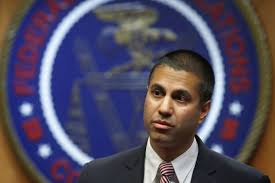
Pai
After significant lobbying by the cable industry, FCC Chairman Ajit Pai made a decision to propose splitting up the 5.9 GHz so-called Vehicle-to-Vehicle (V2V) band to open up 45 MHz for unlicensed Wi-Fi services and leave 30 MHz reserved for emerging crash avoidance technology that will allow cars to communicate with each other to reduce accidents.
Pai has been frustrated by the slow development of intelligent vehicle communications, especially as different competing technologies appear to have delayed deployment as carmakers ponder a technology shift. Pai’s proposal would allow auto manufacturers to debate what kind of spectrum division might be appropriate within the remaining band if different technologies are eventually deployed. But Pai would also quickly move to open up much of the rest of the band for cable industry and consumer Wi-Fi services.
“My proposal would do far more for both automotive safety and Wi-Fi than the status quo,” Pai said, noting he was adding his proposal for FCC consideration at a meeting on Dec. 12.
The cable industry, through its national lobbying group NCTA-The Internet & Television Association, quickly applauded Pai’s proposal, which nearly mirrors the plan recommended by the nation’s biggest cable companies.
“We applaud Chairman Pai’s announcement today that the Commission intends to move forward in considering a new plan for 5.9 GHz spectrum band that will chart a constructive path forward in putting these frequencies to better use for consumers,” said NCTA President Michael Powell. “The Chairman’s proposal will enable the fastest gigabit Wi-Fi speeds in America, ensuring that Wi-Fi can keep pace with growing consumer demand and the deployment of next-generation wireless broadband technologies. We also thank Commissioners O’Rielly and Rosenworcel for their tireless efforts in support of unlicensed spectrum, especially enabling Wi-Fi in the 5.9 GHz band.”
Cable operators including Charter and Comcast want to deploy a large network of Wi-Fi hotspots in the new band to support their growing mobile service operations. Both stand to save substantially by offloading network traffic to their own wireless networks instead of relying on Verizon Wireless, which is contracted to provide 4G LTE service.
Consumers will eventually also be able to purchase in-home routers that will support the new 5.9 GHz band, if Pai’s proposal is approved. The new Wi-Fi band, located between 5.85-5.895 GHz is adjacent to the existing 5.9 GHz Wi-Fi band in the United States (5.725-5.850 GHz)
Expanding available Wi-Fi spectrum may help consumers get faster wireless connections, especially in areas where signal congestion from other users is significant. Some proponents suggest that the new band could allow consumers to experience near-gigabit Wi-Fi speeds, but that will largely be dependent on the equipment used, one’s distance from a Wi-Fi hotspot, and any prevailing wireless traffic congestion.


 Subscribe
Subscribe
It’s a little disappointing. There is an American standard for automotive use in the 5.9 band, but it is barely implemented. I think a few Audis have it, I don’t think others. Dev boards are hard to find. The protocol is a lot like WiFi, except cars send packets and receive packets without forming a connection/session to an SSID. Other than foot-dragging by automotive vendors, the worst problem is that the system is entirely without security. Nothing prevents people from spoofing messages other than the parts being hard to find. Cars don’t transmit traceable unique ids but privacy violations may… Read more »